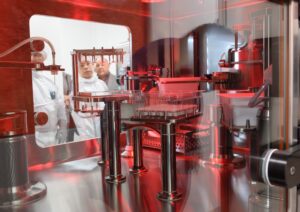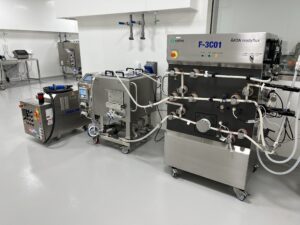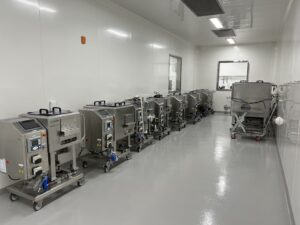Life Sciences
An interview with BioVectra executives at CPHI Barcelona 2nd January 2024

The editorial team at Life Sciences Knowledge Hub, posed a number of searching questions to Marc Sauer, PhD, Chief Science Officer, and Jessica Madigan, Director, Business Development, Nucleic Acid Modalities, of BioVectra, a North American CDMO specialising in clinical-to-commercial scale production capabilities.
Q. You work a wide range of products, such as biologics, small molecules and high-potency APIs, each of which presents unique difficulties and challenges. How do you manage to excel in working with such diverse product types?
Sauer: When you consider the wide range of products that companies like ours deal with, including large molecules, small molecules, plasmida DNA and messenger RNA, it’s quite a diverse field. We specialise in fine chemicals, APIs and drug products. To explain it, let me start with the roots of BioVectra, which has been in operation for 53 years. We began as a diagnostic reagents and fine chemical company, initially extracting peptides and enzymes from animal matter. This early experience led us to develop expertise in protein analytics and handling. As we saw growing interest from our clients in reagents related to biologics, like reducing agents for protein folding, we expanded into fine chemicals. This evolution prompted us to enhance our chemical synthesis capabilities and broaden our scale ranges.
 In the early 2000s, we made the strategic decision to venture into GMP by establishing a facility dedicated to small molecules. We always considered ourselves a specialist in complex chemistry rather than a provider of commodity excipients or over-the-counter APIs. Our focus was on products that remained challenging to manufacture, handle and source. As a result, we refined our expertise in handling potent compounds, tackling projects like taxanes, for instance. We then entered the world of microbial fermentation, working with small metabolites for medical applications in response to a client’s regulatory needs. Within 18 months, we built and validated a facility for microbial fermentation (E. coli) and achieved FDA approval, enabling us to supply the product to our clients.
In the early 2000s, we made the strategic decision to venture into GMP by establishing a facility dedicated to small molecules. We always considered ourselves a specialist in complex chemistry rather than a provider of commodity excipients or over-the-counter APIs. Our focus was on products that remained challenging to manufacture, handle and source. As a result, we refined our expertise in handling potent compounds, tackling projects like taxanes, for instance. We then entered the world of microbial fermentation, working with small metabolites for medical applications in response to a client’s regulatory needs. Within 18 months, we built and validated a facility for microbial fermentation (E. coli) and achieved FDA approval, enabling us to supply the product to our clients.
Our journey thus far has revolved around developing capabilities in: 1) potent compound handling; 2) microbial fermentation; and 3) expanding into the domain of large molecules. Drawing on our two decades of microbial fermentation experience, we entered the market with recombinant proteins, dedicating a separate facility to maintain the distinction between small and large molecules. This move allowed us to cater to clients from the preclinical stage through commercial production.
One potential logical next step could have been delving into mammalian cell culture. However, 2020 and the pandemic led us to consider whether mammalian cell culture was the right choice, given the spotlight on the rise of mRNA. With support from the Canadian Government, we pivoted and have spent the last two years expanding into plasmida DNA, mRNA, lipid formulation and fill finish. This transformation marked a significant investment, totalling around $85 million, encompassing manufacturing scale, process development and process characterisation capabilities.
You might wonder why we chose to enter the realm of plasmid DNA. One key driver was by our existing experience with E. coli production, the same platform used to manufacture plasmid DNA. We prefer stepping into adjacent territories, leveraging our existing equipment, analytical tools and three decades of staff expertise. While plasmida DNA has its unique aspects, we were confident in our ability to design suitable facilities. Furthermore, plasmida DNA serves as the starting material for mRNA production, aligning with our goal of offering mRNA capabilities for both vaccines and therapeutics.
Particularly in the complex supply chain of mRNA, having a single source that can provide vector production, plasmida production, mRNA synthesis, formulation, lipid production and drug product services is invaluable. We can handle the process all the way from a genetic sequence to the final filtered product.
As for mammalian cell culture, it’s not currently one of our offerings. However, this may change in the future.
Q. We know that stability and yields are major pain points when working with mRNA and similar materials. So, what approaches and technologies are you using to address these issues?
Madigan: As you mentioned, the primary challenges associated with mRNA production revolve around stability and product purity. While it may seem that mRNA is relatively new to the industry, it’s important to note that mRNA development has quietly progressed in the background for three to four decades. Industry partners have been diligently working to address these challenges over the years. For instance, a significant immune-stimulatory impurity known as double-stranded RNA is produced as a by-product during transcription; and removing it after production can lead to stability and yield issues. To mitigate this, we’ve integrated available solutions from the market into our processes.
 One such solution involves the use of modified mutant T7 polymerases, specifically engineered to avoid the formation of the troublesome double-stranded RNA impurity. This modification streamlines the manufacturing process, enabling high yields and exceptional purity. Additionally, maintaining stability after mRNA production, especially when encapsulated in lipid nanoparticles, requires strict cold storage. Collaborating with partners such as Acuitas offers access to experts in creating innovative lipids and novel mRNA-lipid nanoparticle formulations. These efforts are geared towards enhancing stability and optimising packaging methods for mRNA.
One such solution involves the use of modified mutant T7 polymerases, specifically engineered to avoid the formation of the troublesome double-stranded RNA impurity. This modification streamlines the manufacturing process, enabling high yields and exceptional purity. Additionally, maintaining stability after mRNA production, especially when encapsulated in lipid nanoparticles, requires strict cold storage. Collaborating with partners such as Acuitas offers access to experts in creating innovative lipids and novel mRNA-lipid nanoparticle formulations. These efforts are geared towards enhancing stability and optimising packaging methods for mRNA.
By leveraging these industry partnerships, we’re well-positioned to deliver these solutions to clients under GMP manufacturing conditions. This stability challenge may remind you of the issues faced with in vaccine distribution, specifically the requirement for cold chain logistics to maintain the vaccine’s integrity at extremely low temperatures.
Another crucial aspect of mRNA production is the stabilisation of long homopolymers. Long homopolymers are often introduced through plasmid DNA as a starting material for mRNA transcription. However, plasmids have inherent instability in these regions, leading to recombination events and challenges in selecting the correct clone, especially for long-term use. In our case, we’ve developed a robust clone screening process that excels in identifying the correct clone from the start. This derisks the occurrence of these issues during large-scale GMP manufacturing, preventing time and cost overruns that might arise from lost poly-A tails, for instance.
One of our notable strengths lies in our analytical processes, which we manage in-house. We have access to both Sanger and next-generation sequencing (NGS) capabilities, along with fragment analysis and gel analysis, to name a few. These tools empower us to efficiently screen and identify the ideal clones, ensuring a smooth and reliable production process.
Q. In the current CDMO landscape, specifically within your market, what are the prevalent challenges and prospects? Also, considering your recent entry into the oligonucleotide-based market, it’s evident that this is a field many are venturing into. Could you elaborate on the challenges and opportunities you foresee?
Sauer: Indeed, everyone is attempting to enter the field, but not everyone will excel. BioVectra has a rich 50-year history in the business and our strategic move into the mRNA space was a logical step, closely aligned with our existing core competencies. Unlike companies that are venturing into this area from scratch, we are not new to the game. We have the right people, the right team and a well-established support structure in place to guide our clients effectively.
Our quality systems have been routinely inspected and approved by regulatory authorities like the US FDA, Health Canada and the PMDA in Japan. We also collaborate with most of the world’s top pharmaceutical companies, with 18 out of the top 20 having inspected our quality systems. This extensive experience positions us well to assist our clients in navigating the intricate regulatory landscape.
 Talent retention poses another hurdle in the CDMO world. While we have been fortunate to maintain low attrition levels, the pandemic introduced new challenges as people reconsidered their lives, potentially leading to relocations and shifts in employment. Nonetheless, we have managed to attract experienced professionals, who wanted to return to Canada or make Canada their new home, strengthening our knowledge base and readiness for new modalities. We actively seek individuals with the right expertise, even if their commitment is for a specific duration. In some cases, we collaborate with experienced individuals on a contract basis to accelerate our learning and avoid common pitfalls.
Talent retention poses another hurdle in the CDMO world. While we have been fortunate to maintain low attrition levels, the pandemic introduced new challenges as people reconsidered their lives, potentially leading to relocations and shifts in employment. Nonetheless, we have managed to attract experienced professionals, who wanted to return to Canada or make Canada their new home, strengthening our knowledge base and readiness for new modalities. We actively seek individuals with the right expertise, even if their commitment is for a specific duration. In some cases, we collaborate with experienced individuals on a contract basis to accelerate our learning and avoid common pitfalls.
Our approach extends to academic and industry collaborations, reinforcing our commitment to continuous learning and growth. The Canadian ecosystem offers a fertile ground for such partnerships. Academic collaborations not only enrich our understanding of the science, but also broaden our problem-solving capabilities. This is crucial, given that the cost of mRNA therapeutics is currently prohibitive for many new therapeutics. We are actively exploring alternative approaches to processes, such as In Vitro Transcription (IVT) reactions, with the aim of delivering high-quality products at a reasonable price.
Change is indeed challenging, but it is necessary for progress. While change may not always lead to the perfect process, it allows us to learn and adapt. It’s true that not everyone has the resources to invest in alternatives, which require both time and money. An example from the past is the initial scepticism surrounding single-use reactors. Many initially questioned the idea of conducting reactions in plastic bags, but eventually it became an accepted and efficient practice.
Q. How does AI impact your industry?
Sauer: AI is undoubtedly a buzzword these days, often overused and misapplied. It’s essential to recognise that AI isn’t a magic bullet that can solve every problem. The real question is how can advanced modelling, machine learning and artificial intelligence contribute to improving our industry? AI on its own won’t provide the answers we seek. In my view, the primary focus should be on machine learning rather than artificial intelligence. I firmly believe that machine learning is poised to revolutionise how we operate processes and conduct lead discovery.
The key ingredient is having the right data and I’d like to emphasise that access to substantial datasets, which can often be found in academic institutions, is crucial. With the right data at our disposal, we can envision designing a lead from scratch and then tailoring our processes to it. This offers a unique opportunity to rethink how we manufacture our products. What I hope to see in the future is a paradigm shift where we create processes and adapt the product to fit the process. Instead of constantly modifying the process, we should strive for process reusability, employing the same upstream and downstream methods, resins, and consumables, while modelling the product to align with the process. This approach could significantly reduce the cost of producing quality medicines and therapeutics, which is one of the pressing challenges in healthcare today.
Modelling is not a novel concept in our industry; practices like quality by design, design of experiments and statistical data interpretation have been in use for two to three decades. Machine learning, AI, or any advanced use of computer technology is not as far-fetched as it may seem. Consider how we approach early toxicology data with databases and modelling – you can already obtain a rough idea of what a compound is capable of. It’s only natural that these technologies will continue to advance. Remember your first personal computer? Now, you carry out the same tasks on your phone. That’s progress over the past 20 to 30 years. The pharmaceutical industry should be no different. AI is both intriguing and potentially dangerous. The question is not whether we should use it, but rather how we should use it and establish regulations to ensure accessibility. It does come with financial and infrastructure requirements, including large servers and extensive data storage.
So, to answer the question of whether AI will play a role, I’d say it already is playing a role in various ways and it has been for some time.


